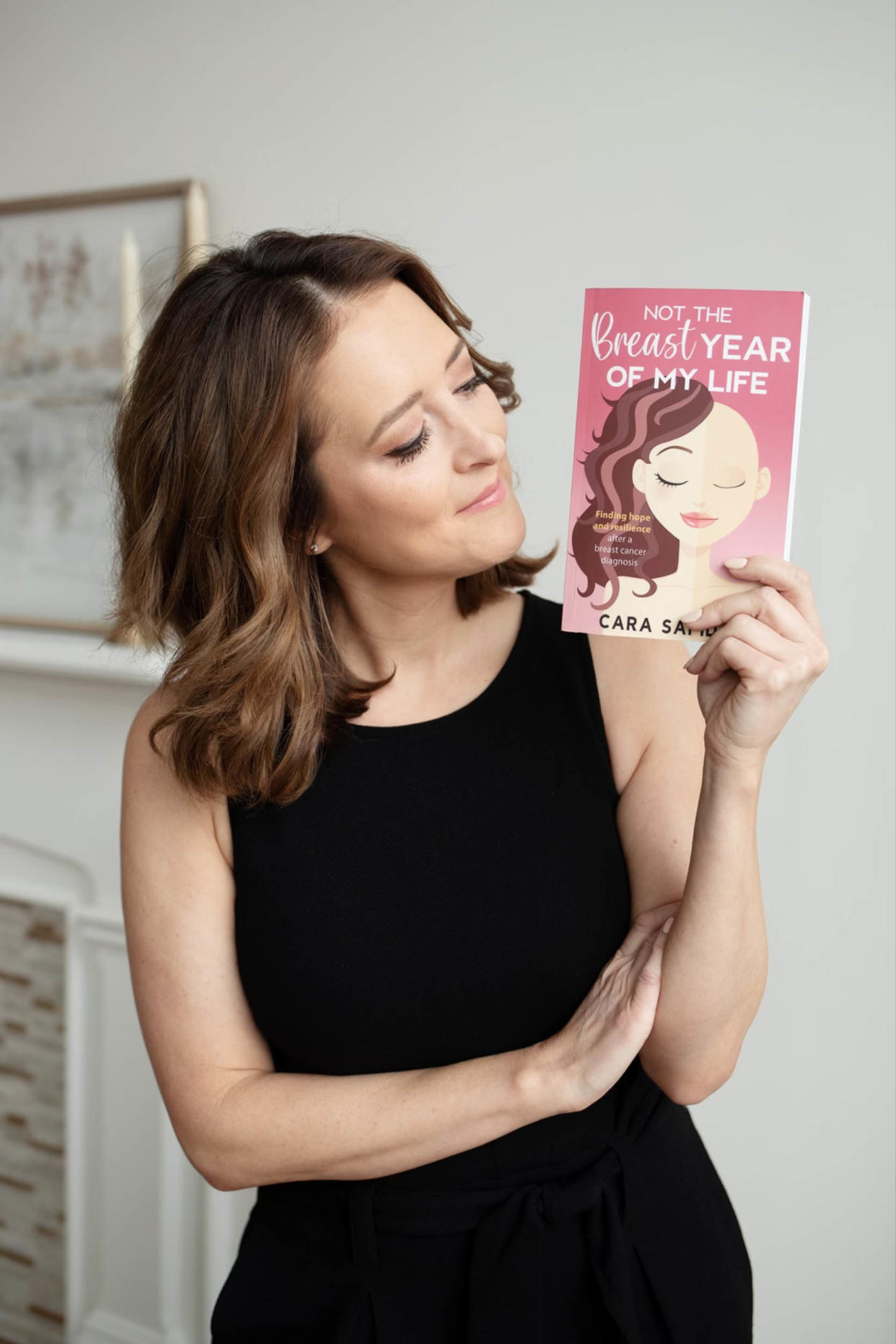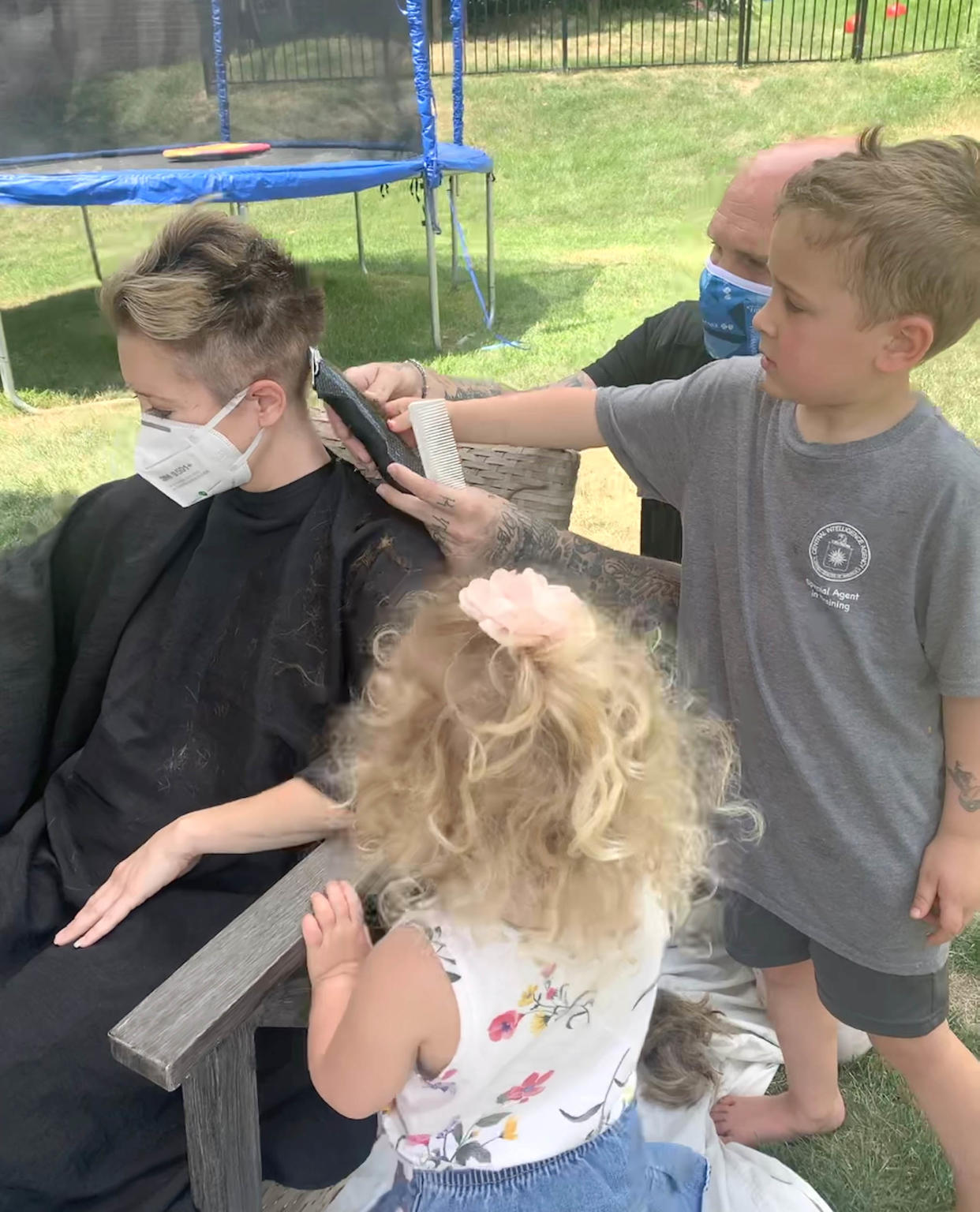TV reporter, 38, finds breast lump after pulling a muscle. It was stage 2 cancer
As soon as pandemic restrictions lifted in 2020, Cara Sapida joined a gym and promptly “pulled all (her) muscles,” she jokes. Trying to ease the pain, she began stretching and noticed something.
“I was stretching my muscles, and that’s how I found the lump,” the now 41-year-old reporter at WPXI-TV, an NBC affiliate in Pittsburgh, tells TODAY.com. “One of my best friends is an ultrasound technician, and she said, ‘Go to your gyno now,’ and I did.”
Sapida eventually learned she had stage 2 triple negative breast cancer — “the most aggressive and the fastest growing,” she says.
The American Cancer Society notes that triple negative breast cancer grows and spreads faster and has a worse prognosis than other types of breast cancers, in part due to having fewer treatment options.
Less than 1 year between mammograms
In 2019, Sapida experienced pain in her armpit and visited her doctor, who recommended she undergo a mammogram, even though she was younger than the recommended screening age.
“They determined (it) was from breastfeeding, like a clogged milk duct,” she recalls. “There was nothing there, and then in between October and the following June, when I found my lump, a lump had formed.”
In 2020, when she tried relieving the tenderness of her achy muscles, she felt the lump “on the edge of her left breast.” She scheduled an appointment with her gynecologist, who "wasn’t overly concerned" but sent Sapida for an ultrasound "just to be safe."
“The ultrasound was obviously suspicious,” Sapida says. “They did the biopsy that day.”

Photo credit: Cristin Goss
The biopsy revealed the lump was cancer, and soon after Sapida started treatment. She qualified for an immunotherapy drug trial lasting 12 weeks, which she received alongside chemotherapy. After a short break, she underwent four more drug treatments followed by a double mastectomy. At the time, her children were 2 and 4, and COVID restrictions were still tight, so she went to her appointments alone. She was also separating from her ex-husband at the time.
“I was going through layers of hardship, which I now have learned a lot of people were going through layers of hardship during that time in the pandemic,” she says. “For me, it felt very overwhelming for a long time. I felt like cancer kicked me when I was down.”
But along the way, her thinking changed.
“I started thinking that it was a blessing that I was going through the divorce during the global pandemic because when I joined that gym, I pulled those muscles and found the lump,” she says. “I asked myself, ‘How long would I have gone before I felt that lump that was just going to continue to grow aggressively?’”
Realizing this helped her “come to terms” with having breast cancer in the middle of so much turmoil, Sapida says.
She had to take time off work because getting COVID-19 while having cancer could have complicated her treatments, but she returned to work after her mastectomy. She candidly shared her experience on social media in the hopes of raising awareness.
“I had a decision to make — either disappear or be honest with our viewers,” she says. “I decided early on that I was going to share and be honest and hope that maybe some women would see the post and get mammograms.”
It worked. She received messages from many who scheduled a test after reading about her experience.
“People weren’t scheduling at that time because everything was shut down,” she says. “There was another wave of comments like, ‘I have to follow up,’ and another wave of, ‘I was also diagnosed.’ So, I was glad that I shared.”
At first, she wore a wig on air, but then decided to ditch it after a month.

“One day, it just felt inauthentic, and I decide that all these viewers know what I experienced. They prayed for me,” she says. “It felt like the right thing to do was to be myself.”
Breast cancer diagnosis between mammograms
Women should have the option to undergo yearly mammograms starting at age 40, according to the American Cancer Society — a little older than Sapida was when she found her lump. While it's possible to be diagnosed with breast cancer between exams, "it is not common," Dr. Arif Kamal, chief patient officer for the American Cancer Society, tells TODAY.com via email.
"When it occurs, it tends to be the more aggressive, fast-growing cancers that are felt by the person as a change in their own body," Kamal continues. "This is why a person knowing their body, talking with their doctors about what changes are worrisome, and monitoring for those changes is important to add to a regular cancer screening schedule."
According to Kamal, changes that may indicate a fast-growing breast cancer include:
A change in the skin overlying the breast.
A mass not associated with normal changes due to the menstrual cycle.
Abnormal discharge or bleeding from the nipple.
"As a general rule, if these changes are seen, a person should contact their doctor," Kamal says.
The type of cancer Sapida has, triple negative breast cancer, is considered fast growing and affects about 10% to 15% of people diagnosed with breast cancer. This type of breast cancer doesn’t have estrogen or progesterone receptors or make the protein HER2, meaning hormone therapy and drugs targeting HER2 do not work.
“The treatment of choice is chemotherapy,” Dr. Amy Tiersten, professor of medicine, hematology and oncology at the Icahn School of Medicine at Mount Sinai and clinical director of breast medical oncology, who did not treat Sapida, previously told TODAY.com. “It is a type of breast cancer that is very responsive to chemotherapy.”
While breast cancer is the second most common cancer found in women, only 9% of new cases will be diagnosed in women under 45, according to the U.S. Centers for Disease Control and Prevention. In younger women, breast cancer often occurs in people with a family history and those who are African American, though other women do develop it. Younger women are also more likely to develop triple negative breast cancer, per the ACS.
‘Fight like a mother’
As Sapida started treatment, a woman told her to “fight like a girl.” That didn’t sound quite right to her.
“In a nanosecond, I replied, ‘I’m going to fight like a mother,’” she says. “That gave me so much strength, which is what I needed at the time.”
Sapida found that much of the language surrounding breast cancer didn’t match her experience.
“When people say, 'You’re a warrior,' that wasn’t resonating with me at all,” she recalls. “I would like to completely rewrite how we look at breast cancer. ... I don’t like the pink ribbons. I don’t like the color as it relates to cancer. It is such an ugly disease. It is a violent, deadly disease that is killing women.”
While her youngest, Lilah, was too young to understand cancer, Sapida explained it the best she could to her then 4-year-old son, Greyson.
“I told him, ‘The medicine the doctors are giving mommy to heal my boobs is going to do something silly. It’s going to make my hair fall out,’” she says. “He was so sweet. He said, ‘Well if your hair falls out, I’m still going to tell you you’re beautiful.’”
When she shaved her head, Greyson stayed true to his word.
“He looked at me and he said, ‘You’re still beautiful,’ and then my 2-year-old goes, ‘Yeah like a hamster!’” she recalls, laughing.

The chemotherapy made her sick, and a few times she needed to be hospitalized because she was dehydrated. Her mom moved in to help her and the children, as friends supported Sapida from a safe distance.
“My friends came to the driveway, and they would drop things off and leave,” she says. “It was just mostly us in the house. It was a very lonely time.”
Laughter felt important to Sapida’s healing.
“We don’t want to just cry all the time. We don’t want to just be sad, and you don’t want pity,” she says. “We don’t want sympathy, we want empathy. And some of us are just laughing through this very difficult journey.”
Now cancer-free, Sapida wrote the book “Not the Breast Year of My Life” about her experience.
“A lot of people were surprised when they read the book that they’re crying one minute and laughing in the next,” she says. “It is because this experience is so overwhelming and so ridiculous. Sometimes you just have to laugh to get through it.”
This article was originally published on TODAY.com
